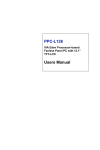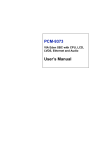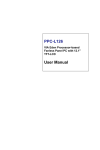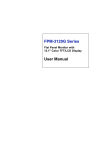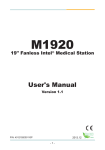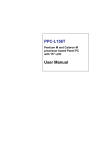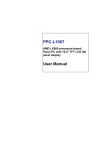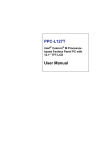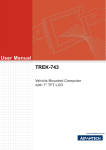Download POC-123 Manual_ed1.book
Transcript
POC-123 VIA Eden Processor-based Fanless Point-of-Care Terminal with 12.1” TFT-LCD Users Manual Copyright This document is copyrighted, © 2003. All rights are reserved. The original manufacturer reserves the right to make improvements to the products described in this manual at any time without notice. No part of this manual may be reproduced, copied, translated or transmitted in any form or by any means without the prior written permission of the original manufacturer. Information provided in this manual is intended to be accurate and reliable. However, the original manufacturer assumes no responsibility for its use, nor for any infringements upon the rights of third parties that may result from such use. Acknowledgements Award is a trademark of Award Software International, Inc. VIA is a trademark of VIA Technologies, Inc. IBM, PC/AT, PS/2 and VGA are trademarks of International Business Machines Corporation. Intel and Pentium are trademarks of Intel Corporation. Microsoft Windows® is a registered trademark of Microsoft Corp. RTL is a trademark of Realtek Semi-Conductor Co., Ltd. UMC is a trademark of United Microelectronics Corporation. Creative is a trademark of Creative Technology LTD. All other product names or trademarks are properties of their respective owners. For more information on this and other Advantech products, please visit our websites at: http://www.advantech.com http://www.advantech.com/medical For technical support and service, please visit our support website at: http://support.advantech.com This manual is for the POC-123. Part No. 2008012320 1st Edition, Printed in Taiwan August 2003 POC-123 User’s Manual ii FCC Class B This equipment has been tested and found to comply with the limits for a Class B digital device, pursuant to Part 15 of the FCC Rules. These limits are designed to provide reasonable protection against harmful interference when the equipment is operated in a residential environment. This equipment generates, uses and can radiate radio frequency energy. If not installed and used in accordance with this user's manual, it may cause harmful interference to radio communications. Note that even when this equipment is installed and used in accordance with this user's manual, there is still no guarantee that interference will not occur. If this equipment is believed to be causing harmful interference to radio or television reception, this can be determined by turning the equipment on and off. If interference is occurring, the user is encouraged to try to correct the interference by one or more of the following measures: • Reorient or relocate the receiving antenna • Increase the separation between the equipment and the receiver • Connect the equipment to a power outlet on a circuit different from that to which the receiver is connected • Consult the dealer or an experienced radio/TV technician for help Warning! Any changes or modifications made to the equipment which are not expressly approved by the relevant standards authority could void your authority to operate the equipment. iii Packing List Before you begin installing your card, please make sure that the following materials have been shipped: • POC-123 series panel PC • User's manual • Accessories for POC-123 - Y-shaped adapter for PS/2 mouse and keyboard - Warranty card - Power cord: USA type - AC/DC power adapter - Driver CD-ROM disc - Mounting kits and packet of screws If any of these items are missing or damaged, contact your distributor or sales representative immediately. Additional Information and Assistance Step 1. Visit the Advantech web site at www.advantech.com where you can find the latest information about the product. Step 2. Contact your distributor, sales representative, or Advantech's customer service center for technical support if you need additional assistance. Please have the following information ready before you call: • Product name and serial number • Description of your peripheral attachments • Description of your software (operating system, version, application software, etc.) • A complete description of the problem • The exact wording of any error messages POC-123 User’s Manual iv Warning! 1. Input voltage rated 18 V ~ 25 Vdc, 3.5 A max 2. Use a 3 V @ 195 mA lithium battery 3. Packing: please carry the unit with both hands, handle with care 4. Maintenance: to properly maintain and clean the surfaces, use only approved products or clean with a dry applicator 5. CompactFlash: Turn off power before inserting or removing CompactFlash storage card. Contact information: Our European representative: Advantech Europe GmbH Kolberger Straße 7 D-40599 Düsseldorf, Germany Tel: 49-211-97477350 Fax: 49-211-97477300 v Safety Instructions 1. Read these safety instructions carefully. 2. Keep this User's Manual for later reference. 3. Disconnect this equipment from any AC outlet before cleaning. Use a damp cloth. Do not use liquid or spray detergents for cleaning. 4. For plug-in equipment, the power outlet socket must be located near the equipment and must be easily accessible. 5. Keep this equipment away from humidity. 6. Put this equipment on a reliable surface during installation. Dropping it or letting it fall may cause damage. 7. The openings on the enclosure are for air convection. Protect the equipment from overheating. DO NOT COVER THE OPENINGS. 8. Make sure the voltage of the power source is correct before connecting the equipment to the power outlet. 9. Position the power cord so that people cannot step on it. Do not place anything over the power cord. 10. All cautions and warnings on the equipment should be noted. 11. If the equipment is not used for a long time, disconnect it from the power source to avoid damage by transient overvoltage. 12. Never pour any liquid into an opening. This may cause fire or electrical shock. 13. Never open the equipment. For safety reasons, the equipment should be opened only by qualified service personnel. 14. If one of the following situations arises, get the equipment checked by service personnel: a. The power cord or plug is damaged. b. Liquid has penetrated into the equipment. c. The equipment has been exposed to moisture. d. The equipment does not work well, or you cannot get it to work according to the user's manual. e. The equipment has been dropped and damaged. f. The equipment has obvious signs of breakage. 15. DO NOT LEAVE THIS EQUIPMENT IN AN ENVIRONMENT WHERE THE STORAGE TEMPERATURE MAY GO BELOW -20° C (-4° F) OR ABOVE 60° C (140° F). THIS COULD DAMAGE THE EQUIPMENT. THE EQUIPMENT SHOULD BE IN A CONTROLLED ENVIRONMENT. 16. CAUTION: DANGER OF EXPLOSION IF BATTERY IS INCORRECTLY REPLACED.REPLACE ONLY WITH THE SAME OR EQUIVALENT TYPE RECOMMENDED BY THE MANUFACTURER, DISCARD USED BATTERIES ACCORDING TO THE MANUFACTURER'S INSTRUCTIONS. The sound pressure level at the operator's position according to IEC 704-1:1982 is no more than 70 dB (A). DISCLAIMER: This set of instructions is given according to IEC 704-1. Advantech disclaims all responsibility for the accuracy of any statements contained herein. POC-123 User’s Manual vi Wichtige Sicherheishinweise 1. Bitte lesen sie Sich diese Hinweise sorgfältig durch. 2. Heben Sie diese Anleitung für den späteren Gebrauch auf. 3. Vor jedem Reinigen ist das Gerät vom Stromnetz zu trennen. Verwenden Sie Keine Flüssig-oder Aerosolreiniger. Am besten dient ein angefeuchtetes Tuch zur Reinigung. 4. Die NetzanschluBsteckdose soll nahe dem Gerät angebracht und leicht zugänglich sein. 5. Das Gerät ist vor Feuchtigkeit zu schützen. 6. Bei der Aufstellung des Gerätes ist auf sicheren Stand zu achten. Ein Kippen oder Fallen könnte Verletzungen hervorrufen. 7. Die Belüftungsöffnungen dienen zur Luftzirkulation die das Gerät vor überhitzung schützt. Sorgen Sie dafür, daB diese Öffnungen nicht abgedeckt werden. 8. Beachten Sie beim. AnschluB an das Stromnetz die AnschluBwerte. 9. Verlegen Sie die NetzanschluBleitung so, daB niemand darüber fallen kann. Es sollte auch nichts auf der Leitung abgestellt werden. 10. Alle Hinweise und Warnungen die sich am Geräten befinden sind zu beachten. 11. Wird das Gerät über einen längeren Zeitraum nicht benutzt, sollten Sie es vom Stromnetz trennen. Somit wird im Falle einer Überspannung eine Beschädigung vermieden. 12. Durch die Lüftungsöffnungen dürfen niemals Gegenstände oder Flüssigkeiten in das Gerät gelangen. Dies könnte einen Brand bzw. elektrischen Schlag auslösen. 13. Öffnen Sie niemals das Gerät. Das Gerät darf aus Gründen der elektrischen Sicherheit nur von authorisiertem Servicepersonal geöffnet werden. 14. Wenn folgende Situationen auftreten ist das Gerät vom Stromnetz zu trennen und von einer qualifizierten Servicestelle zu überprüfen: a - Netzkabel oder Netzstecker sind beschädigt. b - Flüssigkeit ist in das Gerät eingedrungen. c - Das Gerät war Feuchtigkeit ausgesetzt. d - Wenn das Gerät nicht der Bedienungsanleitung entsprechend funktioniert oder Sie mit Hilfe dieser Anleitung keine Verbesserung erzielen. e - Das Gerät ist gefallen und/oder das Gehäuse ist beschädigt. f - Wenn das Gerät deutliche Anzeichen eines Defektes aufweist. 15. VOSICHT: Explisionsgefahr bei unsachgemaben Austausch der Batterie.Ersatz nur durch densellben order einem vom Hersteller empfohlenemahnlichen Typ. Entsorgung gebrauchter Batterien navh Angaben des Herstellers. Der arbeitsplatzbezogene Schalldruckpegel nach DIN 45 635 Teil 1000 beträgt 70dB(A) oder weiger. DISCLAIMER: This set of instructions is given according to IEC704-1. Advantech disclaims all responsibility for the accuracy of any statements contained herein. vii POC-123 User’s Manual viii Contents Chapter 1 General Information ........................................2 1.1 1.2 1.3 1.4 Introduction ....................................................................... 2 General Specifications....................................................... 3 LCD Specifications ........................................................... 6 Dimensions........................................................................ 7 Figure 1.1:Dimensions of POC-123 ............................... 7 Chapter 2 System Setup...................................................10 2.1 A Quick Tour of the Panel PC ........................................ 10 Figure 2.1:Front view of POC-123 panel PC ............... 10 Figure 2.2:Rear view of the POC-123 .......................... 11 Figure 2.3:Side view of the POC-123........................... 11 2.2 Installation Procedures .................................................... 12 2.2.1 2.2.2 2.2.3 2.3 2.4 Running the BIOS Setup Program .................................. 13 Installing System Software.............................................. 14 2.4.1 2.4.2 2.4.3 2.5 Chapter Connecting the power cord ........................................... 12 Connecting the keyboard or mouse .............................. 12 Switching on the power ................................................ 12 Figure 2.4:Bottom view of the POC-123...................... 12 Figure 2.5:Connect the power cord to the DC inlet...... 13 Method 1: Use the Ethernet .......................................... 14 Method 2: Use the COM or parallel port...................... 14 Method 3: Use a CD-ROM........................................... 14 Installing the Drivers....................................................... 15 3 Hardware Installation and Upgrading.........18 3.1 3.2 Introduction ..................................................................... 18 Installing the 2.5" Hard Disk Drive (HDD) .................... 18 3.3 Installing the battery pack ............................................... 20 Figure 3.1:Installing primary 2.5” HDD....................... 19 Figure 3.2:Installing the battery pack ........................... 20 Chapter 4 Jumper Settings and Connectors ..................22 4.1 Jumpers and Connectors.................................................. 22 4.1.1 4.1.2 4.1.3 4.1.4 4.2 Setting jumpers ............................................................. 22 Jumpers and switch....................................................... 23 Table 4.1:Jumpers and their functions.......................... 23 Locating jumpers and switch ........................................ 23 Figure 4.1:Jumpers on the POC-123 motherboard ....... 23 Connectors .................................................................... 24 Table 4.2:Connectors on the POC-123 motherboard.... 24 CMOS Clear for External RTC (J5)................................ 25 ix Figure 4.2:Connectors on the POC-123 motherboard .. 25 Table 4.3:CMOS clear (J5)........................................... 26 4.3 COM-port interface (J2, J6, J7, J8) ................................. 26 4.3.1 4.3.2 4.4 COM2 RS-232/422/485 setting (J2) ............................. 26 Table 4.4:COM2 RS-232/422/485 setting (J2)............. 26 Table 4.5:Serial port default settings ............................ 27 COM1/COM2/COM3/COM4 pin 9 output setting (J6, J7, J8) .................................. 28 Table 4.6:COM1/COM2/COM3/COM4 pin 9 output setting (J6, J7, J8)...................................... 28 VGA interface ................................................................. 29 4.4.1 LCD panel power setting .............................................. 29 4.5 Watchdog Timer Configuration (J4) ............................... 29 4.6 Wake on LAN select (J1) ................................................ 30 Table 4.7:Watchdog activity selection (J4) .................. 29 Table 4.8:Wake-on-LAN select (J1)............................. 30 Chapter 5 PCI Bus Ethernet Interface...........................32 5.1 5.2 Introduction ..................................................................... 32 Installation of Ethernet Driver......................................... 32 5.2.1 5.2.2 5.3 Chapter Further Information ......................................................... 40 6 PCI SVGA Setup ............................................42 6.1 Introduction ..................................................................... 42 6.1.1 6.1.2 6.1.3 6.2 6.3 Installation for Windows 95/98/ME ............................. 43 Installation for Windows NT ........................................ 46 Installation for Windows XP ........................................ 48 Further Information ......................................................... 52 7 Audio Setup.....................................................54 7.1 7.2 Introduction ..................................................................... 54 Installation of the Audio Driver ...................................... 54 7.2.1 7.2.2 7.2.3 Chapter Chipset .......................................................................... 42 Display memory............................................................ 42 Display types................................................................. 42 Installation of the SVGA Driver ..................................... 43 6.2.1 6.2.2 6.2.3 Chapter Installation for Windows 98/2000/ME ......................... 33 Installation for Windows NT ........................................ 38 Installation for Windows 98/2000/ME ......................... 55 Installation for Windows NT ........................................ 60 Installation for Windows XP ........................................ 62 8 Touchscreen ....................................................64 8.1 Introduction ..................................................................... 64 8.1.1 8.1.2 8.1.3 POC-123 User’s Manual General information...................................................... 64 General specifications................................................... 64 Environmental specifications........................................ 64 x 8.2 Installation of Touchscreen Drivers ................................ 65 8.2.1 8.2.2 8.2.3 8.2.4 Chapter Installation for Windows 98 ......................................... 66 Installation for Windows NT ........................................ 68 Installation for Windows 2000 ..................................... 72 Installation for Windows XP ........................................ 76 9 Award BIOS Setup.........................................84 9.1 System test and initialization........................................... 84 9.1.1 9.2 System configuration verification................................. 84 Award BIOS setup .......................................................... 86 9.2.1 9.2.2 9.2.3 9.2.4 9.2.5 9.2.6 9.2.7 9.2.8 9.2.9 9.2.10 9.2.11 9.2.12 9.2.13 Entering setup .............................................................. 86 Figure 9.1:BIOS setup program initial screen .............. 86 Standard CMOS Features setup.................................... 87 Figure 9.2:CMOS Features setup.................................. 87 Advanced BIOS Features setup .................................... 88 Figure 9.3:Advanced BIOS Features setup................... 88 Advanced Chipset Features setup ................................. 89 Figure 9.4:Advanced Chipset Features setup ............... 89 Integrated Peripherals ................................................... 90 Figure 9.5:Integrated Peripherals.................................. 90 Power Management Setup ............................................ 90 Figure 9.6:Power Management Setup........................... 90 PnP/PCI Configurations................................................ 91 Figure 9.7:PnP/PCI Configurations .............................. 91 PC Health Status ........................................................... 91 Figure 9.8:PC Health Status.......................................... 91 Frequency/Voltage Control........................................... 92 Figure 9.9:Frequency/Voltage Control ......................... 92 Load Optimized Defaults.............................................. 93 Figure 9.10:Load BIOS defaults screen........................ 93 Set Password ................................................................. 93 Save & Exit Setup......................................................... 94 Exit Without Saving...................................................... 95 Appendix A Programming the Watchdog Timer .............98 A.1 Programming the Watchdog Timer................................. 98 Appendix B Pin Assignments ...........................................102 B.1 Keyboard and PS/2 Mouse Connector (CN20) ............. 102 B.2 USB port (CN17, CN18)............................................... 102 B.3 COM1 RS-232 serial port (CN13) ................................ 102 B.4 COM3 RS-232 serial port (CN4) .................................. 103 Table B.1:Keyboard and mouse connector (CN20).... 102 Table B.2:USB port (CN17, CN18)............................ 102 Table B.3:COM1 RS-232 serial port (CN13)............. 102 Table B.4:COM3 RS-232 serial port .......................... 103 xi B.5 COM4 RS-232 serial port (CN16) ................................ 103 B.6 COM2 (CN14)............................................................... 104 B.7 Parallel Port Connector (CN11) .................................... 105 B.8 VGA Connector (CN2) ................................................. 106 Table B.5:COM3 RS-232 serial port .......................... 103 Table B.6:COM2 (CN14) .......................................... 104 Table B.7:Parallel Port Connector (CN11)................. 105 Table B.8:VGA connector (CN2)............................... 106 POC-123 User’s Manual xii CHAPTER 1 General Information This chapter gives background information on the POC-123 panel PC. Sections include: • Introduction • General Specifications • LCD Specifications • Dimensions Chapter 1 General Information 1.1 Introduction The POC-123 panel PC is a VIA low-power Eden processor computer that is designed to serve as a Point of Care (POC) and multimedia computer. It is a PC-based system with 12.1" color TFT LCD display, onboard PCI Ethernet controller, multi-COM port interfaces and an audio controller. With a built-in internal IDE connectors, the POC-123 is as compact and user friendly as a multi-function computer. In addition, its "fit anywhere" design makes it very flexible and able to be used in many different kinds of installations. It can be panel mounted or stood upright on a desktop. For Medical/eHealthcare system integrators, this simple, complete, compact and highly integrated multimedia system lets you easily build a panel PC into your medical environment. POC-123 has features such as Fanless, water proof and battery back up. The applications of POC-123 are wide. Common medical applications include patients monitoring system, PACS terminals, and medical system HMI(Human machine interface). It is also suitable for many non-medical applications, including interactive kiosk systems, entertainment management, and car park automation. Our POC-123 is a reliable, cost-effective solution for your application requirements. POC-123 User’s Manual 2 1.2 General Specifications General • Dimensions (W x H x D): 340.5 x 275.0 x 80.0 mm • Weight: 4.25 kg • Power supply: 63 watts, ATX type Input Voltage: +5 V @ 6 A,+3.3 V @ 6 A,+12 V @ 2 A, -12 [email protected] A,-5 V @ 0.5 A, 5 VSB@1 A • Power adaptor: AC/DC Input voltage: 100 ~ 240 VAC Output voltage: 24 V@ 2.3 A • Disk drive housing: Space for one 2.5" HDD, One slim type CD-ROM • Front panel: IP65/NEMA4 compliant Standard PC functions • CPU: Onboard VIA Eden 667 MHz processor • BIOS: Award 256 KB Flash BIOS, supports Plug & Play, APM • System Chipset: VIA PN 133T Chipset (TwisterT) & VT82C686B • Front side bus: 133 MHz • 2nd level cache: 128 KB L1 and 64 KB L2 cache memory on processor • System Memory: Two 168-pin DIMM sockets, accept up to 1 GB SDRAM • PCI bus master IDE interface: Supports two connectors. Each connector has one channel and supports two IDE devices. Each channel supports PIO modes 0 ~ 4, DMA mode 0 ~ 2, and Ultra DMA 33/66/ 100 simultaneously. The secondary connector is designated for the CDROM drive or CompactFlash card. BIOS supports IDE CDROM bootup • Keyboard/mouse connector: Supports standard AT Keyboard and a PS/2 Mouse • Parallel port: One parallel port, supports SPP/EPP/ECP parallel mode. • Serial ports: Four serial ports with three RS-232 ports (COM 1,3, and 4), one RS-232/422/485 port (COM2). All ports are compatible with 16C550 UARTs, +5V/+12V power supply selectable 3 Chapter 1 • Universal serial bus (USB) port: Supports up to two USB ports, USB v1.1 and Intel UHCI v1.1 compatible • Solid State Disk: Supports one 50-pin socket for CompactFlash type I/ II (True IDE mode) and IBM MicroDrive HDD • Watchdog timer: 62-level timer intervals automatically generates system reset or IRQ11 when the system stops due to a program error or EMI. Jumperless selection and software enabled/disabled • Battery: 3.0 V @ 195 mA lithium battery • Power management: Supports power saving modes including Normal/ Standby/Suspend modes. APM 1.2 compliant VGA/LCD Interface • Chipset: VIA Twister chip with integrated Savage4 2D/3D/Video Accelerator • Frame buffer: Supports 8/16/32 MB frame buffer with system memory • Interface: 4X AGP VGA/LCD interface, Support for 9, 12, 15, 18, 24, 36 bit TFT and optional 16- or 24-bit DSTN panel • Display mode: CRT Modes: 1600 x 1200 @ 16bpp (60 Hz), 1024 x 768 @ 32bpp (85 Hz); LCD/Simultaneous Modes: 1280 x 1024 @ 16bpp (60 Hz), 1024 x 768 @16bpp (60 Hz) Audio function • Chipset: VIA 82C686 South Bridge • Audio controller: AC97 Ver. 2.0 compliant interface, Multi stream Direct sound and Direct Sound 3D acceleration • Stereo sound: 18-bit full-duplex codec • Audio interface: Microphone in, Line in, CD audio in; Line out, Speaker L, Speaker R PCI bus Ethernet interface • Chipset: Realtek RTL 8100BL PCI local bus Ethernet controller • Ethernet interface: Full compliance with IEEE 802.3u 100Base-T and 10 Base-T specifications. Includes software drivers and boot ROM • 100/10Base-T auto-sensing capability • Wake-on-LAN: Supports Wake-on-LAN function with ATX power control POC-123 User’s Manual 4 Touchscreen (Optional) Type Analog Resistive Resolution Continuous Light Transmission 75% Controller RS232 interface (uses COM4) Power Consumption <5 V@ 100 mA Software Driver Supports Windows NT/98/ 2000/ME/XP 30 million Durability (touches in a lifetime) Note: The panel PC with the optionally installed touchscreen will share the COM4 port. Once the touchscreen is installed, COM4 cannot be used for other purposes. Optional modules • Memory: 64/128/256/512 MB SDRAM • HDD: 2.5" HDD • Operating System: Microsoft® DOS, Windows 98, NT, ME, 2000, XP • Touchscreen: Elo Analog resistive • Battery pack: Rechargable Li-ion 3S2P 11.1V 4000mAh Environment • Operating Temperature: 0 ~ 40° C (32 ~ 104° F) • Storage Temperature: -20° ~ 60° C • Relative humidity: 10 ~ 95% @ 40° C (non-condensing) • Shock: 10 G peak acceleration (11 msec duration) • Certification: EMC: CE, FCC, VCCI, BSMI Safety: UL-1950/EN-60950 and CB, UL-2601-1/EN60601-1 • Vibration: 5 ~ 500 Hz 1 G RMS Random vibration 5 Chapter 1 1.3 LCD Specifications • Display type: 12.1” TFT LCD • Max. resolution: 800x 600 • Colors: 262 K • Dot size (mm): 0.3075 x 0.3075 • Viewing angle: 90° (minimum) • Luminance: 300 cd/m2 or above • Temperature: 0 ~ 50° C • *VR control: Brightness • LCD MTBF: 50,000 hours • Backlight lifetime: 50,000 hours * The VR control is defined by hot key in DOS or BIOS mode as below: Ctrl-Alt-F3, Ctrl-Alt-F4. Note: The color LCD display installed in the POC-123 is high-quality and reliable. However, it may contain a few defective pixels which do not always illuminate. With current technology, it is impossible to completely eliminate defective pixels. Advantech is actively working to improve this technology. POC-123 User’s Manual 6 1.4 Dimensions Figure 1.1: Dimensions of POC-123 7 Chapter 1 POC-123 User’s Manual 8 CHAPTER 2 System Setup This chapter details system setup on the POC-123 panel PC. Sections include: • A Quick Tour of the Panel PC • Installation procedures • Running the BIOS Setup Program • Installing System Software • Installing the Drivers Chapter 2 System Setup 2.1 A Quick Tour of the Panel PC Before you start to set up the POC-123, take a moment to become familiar with the locations and purposes of the controls, drives, connectors and ports, which are illustrated in the figures below. When you place the POC-123 upright on the desktop, its front panel appears as shown in Figure 2-1. Figure 2.1: Front view of POC-123 panel PC When you turn the panel PC around and look at its rear cover, you will find the I/O section as shown in Fig. 2-2. (The I/O section includes various I/O ports, including serial ports, parallel port, the Ethernet port, USB ports, the Line-in/Line-out jack, and so on.) The battery door cover is at the bottom of the panel PC, as shown in Fig. 2-4 POC-123 User’s Manual 10 ETHERNET JACK USB PORT MAIN POWER SWITCH BATTERY DOOR COVER DC INLET LINE IN JACK LINE OUT JACK MICROPHONE IN JACK SERIAL PORTS VGA PORT PARALLEL PORT Figure 2.2: Rear view of the POC-123 COMPACT CD-ROM DRIVE COMPACT FLASH SOCKET CFC EJECT BUTTON CD-ROM EJECT BUTTON CD-ROM ACTIVITY LIGHT Figure 2.3: Side view of the POC-123 11 Chapter 2 Figure 2.4: Bottom view of the POC-123 2.2 Installation Procedures 2.2.1 Connecting the power cord The POC-123 can only be powered by a DC electrical outlet. Be sure to always handle the power cords by holding the plug ends only. Please follow the Figure 2-5 to connect the male plug of the power cord to the DC inlet of the panel PC. 2.2.2 Connecting the keyboard or mouse Before you start the computer, please connect the Y-shaped adaptor to the PS/2 mouse and keyboard port on the I/O section of the panel PC, then connect the necessary mouse or keyboard to the Y-shaped adapter or serial ports. 2.2.3 Switching on the power When you look at the rear side of the POC-123, you will see the power switch as shown in Figure 2-2. POC-123 User’s Manual 12 Figure 2.5: Connect the power cord to the DC inlet 2.3 Running the BIOS Setup Program Your panel PC is likely to have been properly set up and configured by your dealer prior to delivery. You may still find it necessary to use the panel PC's BIOS (Basic Input-Output System) setup program to change system configuration information, such as the current date and time or your type of hard drive. The setup program is stored in read-only memory (ROM). It can be accessed either when you turn on or reset the panel PC, by pressing the "Del" key on your keyboard immediately after powering on the computer. The settings you specify with the setup program are recorded in a special area of memory called CMOS RAM. This memory is backed up by a battery so that it will not be erased when you turn off or reset the system. Whenever you turn on the power, the system reads the settings stored in CMOS RAM and compares them to the equipment check conducted during the power on self-test (POST). If an error occurs, an error message will be displayed on screen, and you will be prompted to run the setup program. If you want to change the setup of BIOS, refer to Chapter 9 for more detailed information. 13 Chapter 2 2.4 Installing System Software Recent releases of operating systems from major vendors include setup programs which load automatically and guide you through hard disk preparation and operating system installation. The guidelines below will help you determine the steps necessary to install your operating system on the panel PC hard drive. Note: Some distributors and system integrators may have already pre-installed system software prior to shipment of your panel PC. Installing software requires an installed HDD. Software can be loaded in the POC-123 using any of four methods: 2.4.1 Method 1: Use the Ethernet You can use the Ethernet port to download software to the HDD. 2.4.2 Method 2: Use the COM or parallel port You can use Lap Link 6 or similar transmission software. Connect another PC to the POC-123 with an appropriate cable and transmit the software to the POC-123. 2.4.3 Method 3: Use a CD-ROM If required, insert your operating system's installation or setup diskette into the diskette drive until the release button pops out. The BIOS of the panel PC supports system boot-up directly from the CDROM drive. You may also insert your system installation CD-ROM into the CD-ROM drive. Power on your panel PC or reset the system by pressing the "Ctrl"+"Alt"+"Del" keys simultaneously. The panel PC will automatically load the operating system from the diskette or CD-ROM. If you are presented with the opening screen of a setup or installation program, follow the instructions on screen. The setup program will guide you through preparation of your hard drive, and installation of the operating system. If you are presented with an operating system command prompt, such as A:\>, then you must partition and format your hard drive, and manually copy the operating system files to it. Refer to your operating system user's manual for instructions on partitioning and formatting a hard drive. POC-123 User’s Manual 14 2.5 Installing the Drivers After installing your system software, you will be able to set up the Ethernet, SVGA, audio, and touchscreen functions. All drivers are stored in a CD-ROM disc entitled "Drivers and Utilities" which can be found in your accessory box. The standard procedures for installing the drivers are described in Chapters 5, 6, 7, 8 respectively. The various drivers and utilities in the CD-ROM disc have their own text files which help users install the drivers and understand their functions. These files are a very useful supplement to the information in this manual. Note: The drivers and utilities used for the POC-123 panel PCs are subject to change without notice. If in doubt, check Advantech's website or contact our application engineers for the latest information regarding drivers and utilities. 15 Chapter 2 POC-123 User’s Manual 16 CHAPTER 3 Hardware Installation and Upgrading This chapter details installing the POC123 panel PC hardware. Sections include: • Overview of Hardware Installation and Upgrading • Installing the 2.5" Hard Disk Drive (HDD) • Installing the battery pack Chapter 3 Hardware Installation and Upgrading 3.1 Introduction The POC-123 consists of a PC-based computer that is housed in a plastic rear panel and a metal shielding case. You can install HDD, SDRAM and battery pack by removing the rear panel and shielding case. Any maintenance or hardware upgrades can be easily completed after removing the rear panel and shielding case. If you are a systems integrator and need to know how to completely disassemble the panel PC, you can find more useful information in Appendix C. Warning! Do not remove the plastic rear cover until you have verified that no power is flowing within the panel PC. Power must be switched off and the power cord must be unplugged. Every time you service the panel PC, you should be aware of this. 3.2 Installing the 2.5" Hard Disk Drive (HDD) You can attach one enhanced Integrated Device Electronics (IDE) hard disk drive to the panel PC's internal controller which uses a PCI local-bus interface. The advanced IDE controller supports faster data transfer and allows the IDE hard drive to exceed 528 MB. The following are instructions for installation: 1. Detach and remove the plastic rear cover. 2. There is a metal plate which holds the HDD to the upper left-hand side of the metal shielding case. (See Fig. 3-1.) 3. Place the HDD on the metal plate, and tighten the screws. 4. The HDD cable (1 x 44-pin to 1 x 44-pin) is next to the metal plate. Connect the HDD cable to the HDD. The another end of the HDD cable is connected to the PC board (CN21). Make sure that the red/ blue wire corresponds to Pin 1 on the connector, which is labeled on the board. Plug the other end of the cable into the IDE hard POC-123 User’s Manual 18 drive, with Pin 1 on the cable corresponding to Pin 1 on the hard drive. 5. . Put the plastic rear cover on and tighten the screws. Figure 3.1: Installing primary 2.5” HDD 19 Chapter 3 3.3 Installing the battery pack 1. Pull up the battery door cover on the right bottom of POC-123 2. Put the battery pack in, then connect the battery cable to battery connector in the POC-123. Make sure the red wire corresponds to Pin 1 on the connector. 3. Close the battery door cover. Battery door cover Battery cable Battery pack Figure 3.2: Installing the battery pack POC-123 User’s Manual 20 CHAPTER 4 Jumper Settings and Connectors This chapter tells how to set up the panel PC hardware, including instructions on setting jumpers and connecting peripherals, switches and indicators. Be sure to read all the safety precautions before you begin the installation procedures. Sections include: • Jumpers and Connectors • CMOS Clear for External RTC (J5) • COM-port Interface • VGA Interface • Watchdog Timer Configuration Chapter 4 Jumper Settings and Connectors 4.1 Jumpers and Connectors 4.1.1 Setting jumpers You can configure your POC-123 to match the needs of your application by setting jumpers. A jumper is the simplest kind of electrical switch. It consists of two metal pins and a small metal clip (often protected by a plastic cover) that slides over the pins to connect them. To “close” a jumper, you connect the pins with the clip. To “open” a jumper you remove the clip. Sometimes a jumper will have three pins, labeled 1, 2, and 3. In this case, you would connect either pins 1 and 2 or pins 2 and 3. open closed closed 2-3 The jumper settings are schematically depicted in this manual as follows:. open closed closed 2-3 A pair of needle-nose pliers may be helpful when working with jumpers. If you have any doubts about the best hardware configuration for your application, contact your local distributor or sales representative before you make any changes. POC-123 User’s Manual 22 4.1.2 Jumpers and switch The motherboard of the POC-123 has a number of jumpers that allow you to configure your system to suit your applications. The table below lists the function of each of the board’s jumpers. Table 4.1: Jumpers and their functions Label Function J1 LAN power type select J2 COM2 RS-232/422/485 setting J4 Watchdog timer configuration J5 CMOS clear for external RTC J6 COM1/COM2 Pin 9 output type setting J7 COM3 Pin9 output type setting J8 COM4 Pin9 output type setting SW2 Panel type setting (Reserved) 4.1.3 Locating jumpers and switch SW2: Panel type setting J5: CMOS CLEAR J4: Watch dog timer setting INTERNAL SPEAKER J1: Lan power selection J7: COM3 pin 9 output type setting J8: COM4 pin 9 output type setting J2: COM2 RS-232/422/485 setting J6: COM1/COM2 pin 9 output type setting Figure 4.1: Jumpers on the POC-123 motherboard 23 Chapter 4 4.1.4 Connectors Onboard connectors link the POC-123 to external devices such as external hard disk drives or floppy drives. The table below lists the function of each of the board’s connectors. Table 4.2: Connectors on the POC-123 motherboard Label Function CN1 ATX power connector CN3 LVDS channel-1 connector CN4 Inverter power connector CN8 Internal speaker connector (Reserved) CN12 Floppy drive connector (Reserved) CN21 IDE hard drive connector CN22 CD-ROM connector CN23 CFC connector CN26 SIR connector (Reserved) CN27 Battery status connector FAN1 Fan power for system FAN2 Fan power for CPU POC-123 User’s Manual 24 FAN: Fan power for system CN22: CD-ROM connector FAN2: Fan power for CPU CN4: Inverter power connector CN21: IDE hard drive connector CN23: CFC connector CN1: ATX power connector CN27: Battery status connector CN26: SIR connector CN12: Floppy drive connector CN8: Internal speaker connector INTERNAL SPEAKER CN3: lvds channel-1 connector Figure 4.2: Connectors on the POC-123 motherboard 4.2 CMOS Clear for External RTC (J5) Warning! To avoid damaging the computer, always turn off the power supply before setting “Clear CMOS”. Set the jumper back to “Normal operation” before turning on the power supply. This jumper is used to erase CMOS data and reset system BIOS information. The procedure for clearing CMOS is: 1. Turn off system. 2. Short pin 2 and pin 3. 25 Chapter 4 3. Return jumper to pins 1 and 2. 4. Turn on the system. The BIOS is now reset to its default setting. Table 4.3: CMOS clear (J5) *Normal operation Clear CMOS * default setting 4.3 COM-port interface (J2, J6, J7, J8) The panel PC provides four serial ports (COM1, 3, 4: RS-232; COM2: RS-232/422/485) in one COM port connector. 4.3.1 COM2 RS-232/422/485 setting (J2) COM2 can be configured to operate in RS-232, RS-422, or RS-485 mode. This is done via J2. Table 4.4: COM2 RS-232/422/485 setting (J2) *RS-232 RS-422 RS-485 POC-123 User’s Manual 26 Table 4.4: COM2 RS-232/422/485 setting (J2) * default setting The IRQ and the address ranges for COM1, 2, 3, and 4 are fixed. However, if you wish to disable the port or change these parameters later you can do this in the system BIOS setup. The table overleaf shows the default settings for the panel PC’s serial ports. COM1 and COM2 are one set. You can exchange the address range and interrupt IRQ of COM1 for the address range and interrupt IRQ of COM2. After exchanging, COM1's address range is 3F8 ~ 3FF and its request IRQ is IRQ4: and COM2's address range is 2F8 ~ 2FF and its interrupt IRQ is IRQ3. COM3 and COM4 are another set. Their selectable function is the same as the COM1/COM2 set Table 4.5: Serial port default settings Port Address Range Interrupt COM1 3F8 ~ 3FF IRQ4 COM2 2F8 ~ 2FF IRQ3 COM3 3E8 ~ 3EF IRQ10 COM4 2E8 ~ 2EF IRQ5 27 Chapter 4 4.3.2 COM1/COM2/COM3/COM4 pin 9 output setting (J6, J7, J8) Table 4.6: COM1/COM2/COM3/COM4 pin 9 output setting (J6, J7, J8) COM1/COM2 (J6) *Normal operation +5 V output 2 4 6 2 4 6 1 3 5 1 3 5 COM3 (J7) *Normal operation +5 V output 2 4 2 4 1 3 1 3 COM4 (J8) *Normal operation +5 V output +12 V output 2 4 2 4 2 4 1 3 1 3 1 3 *default setting POC-123 User’s Manual 28 4.4 VGA interface The panel PC's AGP VGA interface can drive conventional CRT displays. It is also capable of driving a wide range of flat panel displays, including electroluminescent (EL), gas plasma, passive LCD and active LCD displays. 4.4.1 LCD panel power setting The panel PC's AGP SVGA interface supports 5 V and 3.3 V LCD displays. The LCD cable already has a built-in default setting. You do not need to adjust any jumper or switch to select the panel power. 4.5 Watchdog Timer Configuration (J4) An onboard watchdog timer reduces the chance of disruptions which EMP (electromagnetic pulse) interference can cause. This is an invaluable protective device for standalone or unmanned applications. Setup involves one jumper and running the control software. (Refer to Appendix B.) When the watchdog timer activates (i.e. CPU processing has come to a halt), it can reset the system or generate an interrupt on IRQ11. This can be set via jumper J4 as shown below: Table 4.7: Watchdog activity selection (J4) *System reset IRQ11 * default setting 29 Chapter 4 4.6 Wake on LAN select (J1) The PCM-L126 provides Wake-on LAN function when ATX power is used. To enable Wake-on LAN function, the J1 should be set as shown below: Table 4.8: Wake-on-LAN select (J1) *Normal Power Wake-on-LAN * default setting POC-123 User’s Manual 30 CHAPTER 5 PCI Bus Ethernet Interface This chapter provides information on Ethernet configuration. Sections include: • Introduction • Installation of Ethernet Driver - for Windows 98/2000/ME - for Windows NT - for Windows XP • Further Information Chapter 5 PCI Bus Ethernet Interface 5.1 Introduction The POC-123 is equipped with a high performance 32-bit Ethernet chipset, which is fully compliant with IEEE 802.3 100 Mbps CSMA/CD standards. It is supported by major network operating systems. It is also both 100Base-T and 10Base-T compatible. The Ethernet port provides a standard RJ-45 jack. The network boot feature can be utilized by incorporating the boot ROM image files for the appropriate network operating system. The boot ROM BIOS files are combined with system BIOS, which can be enabled/disabled in the BIOS setup. 5.2 Installation of Ethernet Driver Before installing the Ethernet driver, note the procedures below. You must know which operating system you are using in your POC-123, and then refer to the corresponding installation flow chart. Then just follow the steps described in the flow chart. You will quickly and successfully complete the installation, even if you are not familiar with instructions for Windows. Important: The following windows illustrations are examples only. You must follow the flow chart instructions and pay attention to the instructions which then appear on your screen. Note 1: The CD-ROM drive is designated as "D" throughout this chapter. Note 2: <Enter> means pressing the "Enter" key on the keyboard. POC-123 User’s Manual 32 5.2.1 Installation for Windows 98/2000/ME 1. a. Select "Start," "Settings," "Control Panel," "System." b. Click "Device Manager" and "Other Devices." c. Double Click "PCI Ethernet Controller." 2. a. Choose "Driver" b. Click "Update Driver" 33 Chapter 5 3. Click "Next" 4. a. Choose “Display a list of all the drivers in a specific location,….” b. Click "Next" POC-123 User’s Manual 34 5. a. Select "Network Adaptors" b. Click "Next" 6. a. Click “Have Disk” 35 Chapter 5 7. a. Type the path "D:\POC-123\Lan\WIN98" b. Click "OK" D:\POC-123\Lan\WIN98 Note: Installation for Windows 2000, please Type the path "D:\POC-123\Lan\WIN2K" Installation for Windows ME, please Type the path "D:\POC-123\Lan\WINME" 8. a. Choose “Realtek RTL8139/810K Family PCI Fast Ethernet NIC[8-23-2001]” b. Click "OK" POC-123 User’s Manual 36 9. a. Choose "Next” 10. a. Click “Finish” 37 Chapter 5 5.2.2 Installation for Windows NT 1. Select "Start", "Settings", "Control Panel", and then double click the "Network" icon. 2. a. Select "wire to the network" b. Click “Next” POC-123 User’s Manual 38 3. Press "Have Disk.” 4. a. Type the path: D:\POC-123\Lan\NT40 b. Press the "OK" button. D:\POC-123\Lan\NT40 5. a. Choose the highlighted "RTL8139[A/B/C/8130] PCI Fast Ethernet Adapter". b. Click the "OK" button. 39 Chapter 5 6. Click ok 7. Click Close 5.2.3 Installation for Windows XP Users are not required to install the Ethernet driver themselves. 5.3 Further Information Realtek website: www.realtek.com.tw Advantech websites: www.advantech.com www.advantech.com.tw POC-123 User’s Manual 40 CHAPTER 6 PCI SVGA Setup This chapter provides information on the PCI SVGA setup. Sections include: • Introduction • Installation of SVGA Drivers - for Windows 98/2000/ME - for Windows NT - for Windows XP Further Information Chapter 6 PCI SVGA Setup 6.1 Introduction The POC-123 has an onboard AGP flat panel/VGA interface. The specifications and features are described as follows: 6.1.1 Chipset The POC-123 uses a VIA Twister 8606T chipset from VIA Technology Inc. for its AGP/SVGA controller. It supports many popular LCD, and LVDS LCD displays and conventional analog CRT monitors. The VIA8606T VGA BIOS supports color TFT and DSTN LCD flat panel displays. In addition, it also supports interlaced and non-interlaced analog monitors (color and monochrome VGA) in high-resolution modes while maintaining complete IBM VGA compatibility. Digital monitors (i.e. MDA, CGA, and EGA) are NOT supported. Multiple frequency (multisync) monitors are handled as if they were analog monitors. 6.1.2 Display memory The Twister chip can support 8/16/32MB frame buffer shared with system memory; the VGA controller can drive CRT displays or color panel displays with resolutions up to 1280 x 1024 at 16 M colors. 6.1.3 Display types CRT and panel displays can be used simultaneously. The POC-123 can be set in one of three configurations: on a CRT, on a flat panel display, or on both simultaneously. The system is initially set to simultaneous display mode. If you want to enable the CRT display only or the flat panel display only, please contact VIA Technology Inc., or our sales representative for detailed information. POC-123 User’s Manual 42 6.2 Installation of the SVGA Driver Complete the following steps to install the SVGA driver. Follow the procedures in the flow chart that apply to the operating system that you are using within your POC-123. Notes: 1. The windows illustrations in this chapter are intended as examples only. Please follow the listed steps, and pay attention to the instructions which appear on your screen. 2. For convenience, the CD-ROM drive is designated as "D" throughout this chapter. 3. <Enter> means pressing the “Enter” key on the keyboard. 6.2.1 Installation for Windows 95/98/ME 1. a. Select "Start", "Settings", "Control Panel", "System. b. Click the “Device Manager” and “Display adapter” items. c. Remove the “Standard PCI Graphics Adapter (VGA)” item. d. Click “OK”. 43 Chapter 6 2. a. Choose the "Driver" label. b. Click "Update Driver…" 3. Click "Next" POC-123 User’s Manual 44 4. Click "Next" 5. Click “Have Disk…” 6. a. Type D:\POC-123\VGA\Win9x_ME b. Click”OK” D:\POC-123\VGA\Win9x_ME 45 Chapter 6 Installation for Windows 2000, please Type the path "D:\POC123\Vga\Win2000"in this step. 7. Press “Finish” to reboot. 6.2.2 Installation for Windows NT 1. a. Select “Start”, “settings”, “Control Panel” b. Double click the”Display” icon. 2. a. Choose the “Settings” label b. Press the “Display Type” button. POC-123 User’s Manual 46 3. Press the “Change…” button. 4. Click the “Have Disk…” button. 5. Click “OK” D:\POC-123\Vga\WinNT 47 Chapter 6 6.2.3 Installation for Windows XP 1. Select "System", "Settings", "Control Panel" and double click the "system" icon. 2. Choose “Hardware” and “Device Manager”, press “OK” button. POC-123 User’s Manual 48 3. Choose “Video Controller (VGA Compatible), press “OK” button. 4. Choose "Driver”, “Update Driver”, press “OK” button. 49 Chapter 6 5. Choose “Install from a list.....”, press “Next”. 6. Choose “Don’t search. I will....”, press “Next” button. POC-123 User’s Manual 50 7. Choose “Display adapters”, press “Next” button. 8. Type the path D:\POC-123\Vga\WINXP then press “OK” button. D:\POC-123\Vga\WINXP 9. Choose “S3 Graphics Twister” then press “Next” button. 51 Chapter 6 10. Once all the driver files have been copied, click “Finish”. 11. You will then be prompted to restart your computer to complete the driver installation. Click “Yes”. 6.3 Further Information For further information about the AGP/VGA installation in your POC123, including driver updates, troubleshooting guides and FAQ lists, visit the following web resources: VIA website: www.via.com.tw Advantech websites: www.advantech.com www.advantech.com.tw After installing the VGA driver under Win 98, if you want to play a VCD, please install Directx 8.1 (or higher) which you can find at www.microsoft.com. POC-123 User’s Manual 52 CHAPTER 7 Audio Setup This chapter provides information on the Audio setup. Sections include: • Introduction • Installation of Audio Driver - for Windows 98/2000/ME - for Windows NT - for Windows XP Chapter 7 Audio Setup 7.1 Introduction The POC-123's on-board audio interface provides high-quality stereo sound and FM music synthesis (ESFM) by using the VIA VT82C686 audio controller from VIA. The audio interface can record, compress, and play back voice, sound, and music with built-in mixer control. The POC-123 on board audio interface also supports the Plug and Play (PnP) standard and provides PnP configuration for the audio, FM, and MPU-104 logical devices. It is compatible with Sound Blaster™; Sound Blaster Pro™ version 3.01, voice and music functions. The ESFM synthesizer is register compatible with the OPL3 and has extended capabilities. 7.2 Installation of the Audio Driver Before installing the audio driver, please take note of the procedures detailed below. You must know which operating system you are using in your POC-123, and then refer to the corresponding installation flow chart. Just follow the steps in the flow chart. You can quickly and successfully complete the installation, even though you are not familiar with instructions for Windows. Notes: 1. The windows illustrations in this chapter are intended as examples only. Please follow the listed steps, and pay attention to the instructions which appear on your screen. 2. For convenience, the CD-ROM drive is designated as "D" throughout this chapter. 3. <Enter> means pressing the “Enter” key on the keyboard. POC-123 User’s Manual 54 7.2.1 Installation for Windows 98/2000/ME 1. a. Select "Start", "Settings", "Control Panel", and double click the "System" icon. b. Click the "Device Manager" and "PCI Multimedia Audio Device" items. c. Select "Properties" 2. Select “Driver” tab, click “Update Driver” 55 Chapter 7 3. Click “Next “ 4. Choose “Display a list of all the drivers in a specific location...” then Click “Next “ POC-123 User’s Manual 56 5. choose “Sound, video and game controllers”, click “Next “ 6. Click “Have Disk “ 57 Chapter 7 7. a. Type the path D:\POC-123\Audio\98SE_Me_2K_XP\Win98SE b. Click “OK” D:\POC-123\Audio\98SE_Me-Me_2K_XP\Win98SE Installation for Win 2000, type D:\POC-123\Audio\98SE_Me_2K_XP\Win2000 Installation for Win Me, type D:\POC-123\Audio\98SE_Me_2K_XP\Win ME 8. Select “VIA PCI Audio controller”, Click “OK” POC-123 User’s Manual 58 9. Click “Next” 10. Click “Finish” 59 Chapter 7 7.2.2 Installation for Windows NT 1. Click "Start" and select "Settings". Click "Control Panel" and double-click "Multimedia". 2. In the Multimedia Properties window, select the "Devices" tab. Then select the "Audio Devices" item, and click "Add...". POC-123 User’s Manual 60 3. In the Add window, select the "Unlisted..." item and click "OK". 4. When the Install Driver window opens, put the utility disc in the CD drive. Type: D:\POC-123\Audio\WinNT Then click "OK". D:\POC-123\Audio\WinNt 5. In the Add Unlisted or Updated Driver window, select the "VIA PCI Audio controller" item. Then click "OK". 61 Chapter 7 6. In the System Setting Change window, click "Restart Now". 7.2.3 Installation for Windows XP After installing Windows XP, the system can automatically detect the audio hardware and install the driver from the driver database in Windows XP when the system reboots. POC-123 User’s Manual 62 CHAPTER 8 Touchscreen This chapter provides information on the touchscreen setup. Sections include: • Introduction • Installation of Touchscreen Drivers - for Windows 98/ME - for Windows NT - for Windows 2000 - for Windows XP Chapter 8 Touchscreen 8.1 Introduction 8.1.1 General information The POC-123's optional touchscreen incorporates advanced second-generation 5-wire resistive, impact-resistant technology. It allows 75% light transmission. The resistive model has an antiglare surface. This model provides greatly enhanced visual resolution. It also has new improved scratch-resistant features. The touchscreen is manufactured from UL-recognized components. Its fire resistance meets the UL-746C, 19 mm (0.75") flame test standard. Systems incorporating the touchscreen, controllers, and cables have been approved to FCC Class A and Class B standards. For more detailed information, please visit the following websites: www.elotouch.com 8.1.2 General specifications Please refer to Chapter 1, Section 1.2 of this manual. 8.1.3 Environmental specifications Temperature:-20° ~ 50° C (operating) -40° ~ 70° C (storage) Relative humidity: 90 RH at 35° C (operating) 90 RH at 35° C for 240 hours, non-condensing (storage) Chemical resistance: The active area of the touchscreen is resistant to the following chemicals when exposed for a period of one hour at a temperature of 21° C (71° F): - Acetone - Methylene chloride - Methyl ethyl ketone - Isopropyl alcohol - Hexane POC-123 User’s Manual 64 - Ammonia-based glass cleaners - Turpentine - Mineral spirits - Foods and beverages 8.2 Installation of Touchscreen Drivers The touchscreen driver for Windows contains a native, 32-bit driver and a 32-bit control panel program for the POC-123 system. To facilitate installation of the touchscreen driver, you should read the instructions in this section carefully before you attempt installation. Notes: 1. The windows illustrations in this chapter are intended as examples only. Please follow the listed steps, and pay attention to the instructions which appear on your screen. 2. For convenience, the CD-ROM drive is designated as "D" throughout this chapter. 3. <Enter> means pressing the “Enter” key on the keyboard. 65 Chapter 8 8.2.1 Installation for Windows 98 1. a. Select "Start", "Run” b. Type the path “D:\POC-123\Touchscreen\Windows 98-Me Driver\Setup.exe” c. Click “OK” D:\POC-123\Touchscreen\Windows 98-Me Driver\Setup.exe 2. Click “Yes” POC-123 User’s Manual 66 3. Select "Smart serial controller in COM4". Then press "OK" button. 4. Press "Yes" to restart your POC-123 67 Chapter 8 5. After re-boot, please click the target point to calibrate your touch screen. 8.2.2 Installation for Windows NT 1. a. Select "Start", "Run" b. Type the path “D:\POC-123\Touchscreen\Windows NT Driver” c. Click "Ok". D:\POC-123\Touchscreen\Windows NT Driver POC-123 User’s Manual 68 2. Click “Next”. 3. Select the directory path 69 Chapter 8 4. Choose a suitable item 5. Choose COM4 and press "O.K" POC-123 User’s Manual 70 6. Click "O.K" to restart your POC-123. 7. Calibrate your touch screen. 71 Chapter 8 8.2.3 Installation for Windows 2000 1. a. Select "Start", "Run” b. Type the path “D:\POC-123\Touchscreen\Windows 2000-XP Driver” c. Click “OK” D:\POC-123\Touchscreen\Windows 2000-XP Driver 2. Click “Next” POC-123 User’s Manual 72 3. Click "Yes". 4. Click "Yes" to accept the agreement. 73 Chapter 8 5. Select' COM4, then press "Next". 6. Press "Finish" then select "Yes" to restart your POC-123. POC-123 User’s Manual 74 7. After reboot, calibrate touch screen. 75 Chapter 8 8.2.4 Installation for Windows XP To install the software to your computer, you must have Windows 2000 or XP system running. If you have an older version PenMount Windows 2000 driver installed in your system, please remove it first. Follow the steps below to install the PenMount Windows 2000/XP driver 1. Please note that the installation procedures will be different, depending on different computer systems. If your screen shows the following display, select ”Install from a list or specific location (Advanced)” and press ‘Next’ and go to Step 5. for continuous installation. D:\Touchscreen\Windows 2000-XP Driver V2.0\Setup.exe POC-123 User’s Manual 76 2. If your screen’s message is not shown as Fig. 1 , then from “Start”, select “Control Panel”, select “System”, select “Hardware”, select “Device Manager”, then double click the “Unknown device” 3. The next screen you should see is shown below, select “Driver”, then ”Reinstall Driver” 77 Chapter 8 4. Select “Install from a list or specific location (Advanced)”, and click ”Next” 5. Insert the POC-123 drivers, select ”Search for best driver in these locations” and choose ”Include this location in the search”, and click ‘Next” POC-123 User’s Manual 78 6. The installation is finished. Click ”Finish” 7. The screen will now show “Elo series touch and Elo touch” under “Mice and other pointing devices” as shown below if your installation was successful. Otherwise, you need to go back to Step 1 to Step 6 to reinstall the driver again 79 Chapter 8 8. Please select the CD-ROM to start installation 9. The screen displays copying "installation wizard" and "PenMount Utilities Installation” screen plus "a welcome" message appear. Select “Next” POC-123 User’s Manual 80 10. The next screen is the "Software License Agreement", select "I accept the terms is the license" and click “Next” 11. The next screen is “Ready to Install the Program”. Select “Install” 81 Chapter 8 12. The next screen is ”InstallShield Wizard Completed and system asks to ‘Reboot the system’, select ”Yes” 13. After system reboot, your touch system should be working now, please “Calibrate” at this time. POC-123 User’s Manual 82 CHAPTER 9 Award BIOS Setup This chapter describes how to set BIOS configuration data. Chapter 9 Award BIOS Setup The POC-123 comes with an Award BIOS chip that contains the ROM setup for your system. This chip serves as an interface between the processor and the rest of the mainboard's components. This chapter explains the information contained in the setup program and tells you how to modify the settings according to your system configuration. Some setup items will not be explained, because it is recommended that users do not change such items. Note: Values for the various setup items that appear on your own screen (including default values) may not be the same as the values shown on the screen figures in this chapter. This is because the BIOS is revised and updated from time to time. If in doubt, check Advantech's website for the latest BIOS versions and related information. 9.1 System test and initialization These routines test and initialize board hardware. If the routines encounter an error during the tests, you will either hear a few short beeps or see an error message on the screen. There are two kinds of errors: fatal and non-fatal. The system can usually continue the boot up sequence with non-fatal errors. Non-fatal error messages usually appear on the screen along with the following instructions: press <F1> to RESUME Write down the message and press the F1 key to continue the bootup sequence. 9.1.1 System configuration verification These routines check the current system configuration against the values stored in the board’s CMOS memory. If they do not match, the program outputs an error message. You will then need to run the BIOS setup program to set the configuration information in memory. There are three situations in which you will need to change the CMOS settings: 1. You are starting your system for the first time 2. You have changed the hardware attached to your system POC-123 User’s Manual 84 3. The CMOS memory has lost power and the configuration information has been erased. The POC-123 CMOS memory has an integral lithium battery backup. The battery backup should last ten years in normal service, but when it finally runs down, you will need to replace the complete unit. 85 Chapter 9 9.2 Award BIOS setup Award’s BIOS ROM has a built-in Setup program that allows users to modify the basic system configuration. This type of information is stored in battery-backed CMOS RAM so that it retains the Setup information when the power is turned off. 9.2.1 Entering setup Power on the computer and press <Del> immediately. This will allow you to enter Setup. Figure 9.1: BIOS setup program initial screen POC-123 User’s Manual 86 9.2.2 Standard CMOS Features setup When you choose the Standard CMOS Features option from the Initial Setup Screen menu, the screen shown below is displayed. This standard Setup Menu allows users to configure system components such as date, time, hard disk drive, floppy drive and display. Once a field is highlighted, on-line help information is displayed in the left bottom of the Menu screen. Figure 9.2: CMOS Features setup 87 Chapter 9 9.2.3 Advanced BIOS Features setup By choosing the Advanced BIOS Features Setup option from the Initial Setup Screen menu, the screen below is displayed. Users are not encouraged to run the BIOS and Chipset Features setup programs. Your system should have been fine-tuned before shipping. Improper setup may cause the system to fail, so consult your dealer before making any changes. Figure 9.3: Advanced BIOS Features setup POC-123 User’s Manual 88 9.2.4 Advanced Chipset Features setup By choosing the Advanced Chipset Features option from the Initial Setup Screen menu, the screen below is displayed. Figure 9.4: Advanced Chipset Features setup Note: It is strongly recommended that setup items in this section NOT be changed, because advanced knowledge is required to effect such changes. 89 Chapter 9 9.2.5 Integrated Peripherals Choosing the Integrated Peripherals option from the Initial Setup Screen menu should produce the screen below. Here we see the default values for the POC-123. Figure 9.5: Integrated Peripherals 9.2.6 Power Management Setup By choosing the Power Management Setup option from the Initial Setup Screen menu, the screen below is displayed. Figure 9.6: Power Management Setup POC-123 User’s Manual 90 9.2.7 PnP/PCI Configurations By choosing the PnP/PCI Configurations option from the Initial Setup Screen menu, the screen below is displayed. Figure 9.7: PnP/PCI Configurations 9.2.8 PC Health Status The PC Health Status option displays information such as CPU and motherboard temperatures, fan speeds, and core voltage. Figure 9.8: PC Health Status 91 Chapter 9 9.2.9 Frequency/Voltage Control By choosing the Frequency/Voltage Control option from the Initial Setup Screen menu, the screen below is displayed. Figure 9.9: Frequency/Voltage Control Warning Incorrect settings in Frequency/Voltage Control may damage the system CPU, video adapter, or other hardware. POC-123 User’s Manual 92 9.2.10 Load Optimized Defaults Load Optimized Defaults loads the default system values directly from ROM. If the stored record created by the Setup program should ever become corrupted (and therefore unusable), these defaults will load automatically when you turn the POC-123 system on. Figure 9.10: Load BIOS defaults screen 9.2.11 Set Password Note To enable this feature, you should first go to the Advanced BIOS Features menu, choose the Security Option, and select either Setup or System, depending on which aspect you want password protected. Setup requires a password only to enter Setup. System requires the password either to enter Setup or to boot the system. A password may be at most 8 characters long. To Establish Password 1. Choose the Set Password option from the CMOS Setup Utility main menu and press <Enter>. 2. When you see “Enter Password,” enter the desired password and press <Enter>. 93 Chapter 9 3. At the “Confirm Password” prompt, retype the desired password, then press <Enter>. 4. Select Save to CMOS and EXIT, type <Y>, then <Enter>. To Change Password 1. Choose the Set Password option from the CMOS Setup Utility main menu and press <Enter>. 2. When you see “Enter Password,” enter the existing password and press <Enter>. 3. You will see “Confirm Password.” Type it again, and press <Enter>. 4. Select Set Password again, and at the “Enter Password” prompt, enter the new password and press <Enter>. 5. At the “Confirm Password” prompt, retype the new password, and press <Enter>. 6. Select Save to CMOS and EXIT, type <Y>, then <Enter>. To Disable Password 1. Choose the Set Password option from the CMOS Setup Utility main menu and press <Enter>. 2. When you see “Enter Password,” enter the existing password and press <Enter>. 3. You will see “Confirm Password.” Type it again, and press <Enter>. 4. Select Set Password again, and at the “Enter Password” prompt, don’t enter anything; just press <Enter>. 5. At the “Confirm Password” prompt, again don’t type in anything; just press <Enter>. 6. Select Save to CMOS and EXIT, type <Y>, then <Enter>. 9.2.12 Save & Exit Setup If you select this option and press <Y> then <Enter>, the values entered in the setup utilities will be recorded in the chipset’s CMOS memory. The microprocessor will check this every time you turn your system on and use the settings to configure the system. This record is required for the system to operate. POC-123 User’s Manual 94 9.2.13 Exit Without Saving Selecting this option and pressing <Enter> lets you exit the Setup program without recording any new values or changing old ones. 95 Chapter 9 POC-123 User’s Manual 96 Appendix A Programming the Watchdog Timer The POC-123 is equipped with a watchdog timer that resets the CPU or generates an interrupt if processing comes to a standstill for any reason. This feature ensures system reliability in industrial standalone or unmanned environments. Appendix A Programming the Watchdog Timer A.1 Programming the Watchdog Timer To program the watchdog timer, you must write a program which writes I/ O port address 443 (hex). The output data is a time interval value. The value range is from 01 (hex) to 3E (hex), and the related time interval is from 1 sec. to 62 sec. Data Time Interval 01 1 sec. 02 2 sec. 03 3 sec. 04 4 sec. • • • • • • 3E 62 sec. After data entry, your program must refresh the watchdog timer by rewriting the I/O port 443 (hex) while simultaneously setting it. When you want to disable the watchdog timer, your program should read I/O port 443 (hex). POC-123 User’s Manual 98 The following example shows how you might program the watchdog timer in BASIC: 10 REM Watchdog timer example program 20 OUT &H443, data REM Start and restart the watchdog 30 GOSUB 1000 REM Your application task #1, 40 OUT &H443, data REM Reset the timer 50 GOSUB 2000 REM Your application task #2, 60 OUT &H443, data REM Reset the timer 70 X=INP (&H443) REM, Disable the watchdog timer 80 END 1000 REM Subroutine #1, your application task • • • • • • 1070 RETURN 2000 REM Subroutine #2, your application task • • • • • • 2090 RETURN 99 Appendix A POC-123 User’s Manual 100 Appendix B I/O Pin Assignments Appendix B Pin Assignments B.1 Keyboard and PS/2 Mouse Connector (CN20) Table B.1: Keyboard and mouse connector (CN20) Pin Signal 1 2 3 4 5 6 KB_DAT MS-DAT GND +5 V KB_CLK MS-CLK B.2 USB port (CN17, CN18) Table B.2: USB port (CN17, CN18) Pin Signal 1 2 3 4 VCC DATADATA+ GND B.3 COM1 RS-232 serial port (CN13) Table B.3: COM1 RS-232 serial port (CN13) Pin Signal Pin Signal 1 3 5 7 9 DCD TxD GND RTS RI 2 4 6 8 RXD DTR DSR CTS POC-123 User’s Manual 102 B.4 COM3 RS-232 serial port (CN4) Table B.4: COM3 RS-232 serial port Pin Signal Pin Signal 1 3 5 7 9 DCD TxD GND RTS RI 2 4 6 8 RXD DTR DSR CTS B.5 COM4 RS-232 serial port (CN16) Table B.5: COM3 RS-232 serial port Pin Signal Pin Signal 1 3 5 7 9 DCD TxD GND RTS RI 2 4 6 8 RXD DTR DSR CTS 103 Appendix B B.6 COM2 (CN14) Table B.6: COM2 (CN14) Pin Signal RS-232 RS-422 RS-485 1 2 3 4 5 6 7 8 9 DCD RX TX DTR GND DSR RTS CTS RI TXTX+ RX+ RXGND DATADATA+ POC-123 User’s Manual 104 B.7 Parallel Port Connector (CN11) Table B.7: Parallel Port Connector (CN11) Pin Signal 1 STROBE* 3 D1 5 D3 7 D5 9 D7 11 BUSY 13 SLCT 15 ERR* 17 SLCTINI* 19 GND 21 GND 23 GND 25 GND * low active Pin Signal 2 4 6 8 10 12 14 16 18 20 22 24 D0 D2 D4 D6 ACK* PE AUTOFD* INIT* GND GND GND GND 105 Appendix B B.8 VGA Connector (CN2) Table B.8: VGA connector (CN2) Pin Signal 1 2 3 4 5 6 7 8 9 10 11 12 13 14 15 RED GREEN BLUE N/A GND GND GND GND N/A GND N/A SPDAT HSYNC VSYNC SPCLK POC-123 User’s Manual 106






















































































































